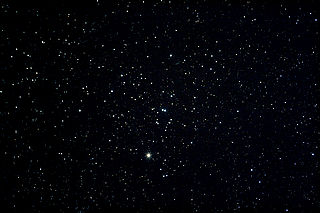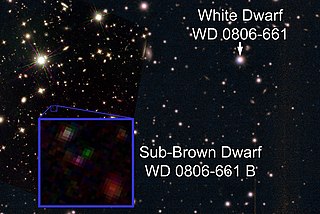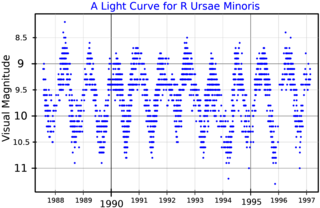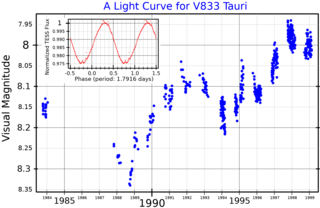
The Hyades is the nearest open cluster and one of the best-studied star clusters. Located about 153 light-years away from the Sun, it consists of a roughly spherical group of hundreds of stars sharing the same age, place of origin, chemical characteristics, and motion through space. From the perspective of observers on Earth, the Hyades Cluster appears in the constellation Taurus, where its brightest stars form a "V" shape along with the still-brighter Aldebaran. However, Aldebaran is unrelated to the Hyades, as it is located much closer to Earth and merely happens to lie along the same line of sight.
21 Aquarii is a single star in the zodiac constellation of Aquarius. 21 Aquarii is the Flamsteed designation. It is visible to the naked eye as a dim, orange-hued star with an apparent visual magnitude of 5.49. This object is a member of the HR 1614 moving group, and is moving closer to the Earth with a heliocentric radial velocity of −24.5 km/s.

HD 183144 is a suspected variable star in the equatorial constellation of Aquila. It is a hot giant star about 1,130 light years away.
HD 156768 is a double star in the southern constellation of Ara, with a combined apparent magnitude of 5.86. The brighter component is a sixth magnitude bright giant or supergiant star with a stellar classification of G8Ib/II. The magnitude 9.6 companion lies at an angular separation of 1.81″ along a position angle of 184°.
HD 30442 is a solitary star in the northern circumpolar constellation Camelopardalis. It is faintly visible to the naked eye with an apparent magnitude of 5.47 and is estimated to be 403 light years away from the Solar System. The object has a heliocentric radial velocity of −37 km/s, indicating that it is drifting closer.

W Andromedae is a variable star in the constellation of Andromeda. It is classified as a Mira variable and S-type star, and varies from an apparent visual magnitude of 14.6 at minimum brightness to a magnitude of 6.7 at maximum brightness, with a period of approximately 397.3 days.

Stein 2051 is a nearby binary star system, containing a red dwarf and a degenerate star, located in constellation Camelopardalis at about 18 ly from Earth.

WD 0806−661, formally named Maru, is a DQ white dwarf with an extremely cold Y-type substellar companion, located in the constellation Volans at 62.7 light-years from Earth. The companion was discovered in 2011, and is the only known Y-type companion to a star or stellar remnant. At the time of its discovery WD 0806-661 B had the largest actual and apparent separation of any known planetary-mass object, as well as being the coldest directly imaged substellar object then known.
ι2 Muscae, Latinised as Iota2 Muscae, is a blue-white-hued star in the southern constellation Musca, near the constellation's southern border with Chamaeleon. It has an apparent visual magnitude of 6.62, which is just below the normal limit of stellar brightness visible to the naked eye. Based upon parallax measurements, it is located around 492 light-years from the Sun. It is a member of the Hyades Stream, but is not part of the Hyades or Praesepe open clusters.
κ Gruis, Latinised as Kappa Gruis, is a solitary star in the southern constellation of Grus. With an apparent magnitude of 5.37, it is visible to the naked eye as a dim, orange-hued point. The distance to this system, as determined from an annual parallax shift of 8.87 mas as seen from the Earth, is roughly 368 light years. It is drifting further away with a heliocentric radial velocity of +18 km/s. It is a member of the Arcturus moving group.

Gliese 402 is a star located 22.7 light years from the Solar System. Located in the constellation of Leo, it is also known as Wolf 358 from its entry in Max Wolf's star catalogue. The stars nearest to Gliese 402 are Gliese 393, at 3.43 light years, Gliese 408, at 6.26 light years, and Gliese 382 at 6.66 light years.

R Ursae Minoris is a star in the constellation Ursa Minor. A red giant of spectral type M7IIIe, it is a semiregular variable ranging from magnitude 8.5 to 11.5 over a period of 325 days.

R Cancri is a Mira variable in the constellation Cancer. Located approximately 250 parsecs (830 ly) distant, it varies between magnitudes 6.07 and 12.3 over a period of approximately 357 days. At its brightest, it is very faintly visible to the naked eye.

WD J1953−1019 is a hierarchical triple system of white dwarfs located at about 130 parsecs from the Earth. This is the first triple system of white dwarfs to be resolved. The three white dwarfs have an atmosphere of pure hydrogen and a mass of about 0.6 times that of the Sun.

HD 283750, also known as V833 Tauri, is a K-type main-sequence star 57 light-years away from the Sun. The star is much younger than the Sun's at 1 billion years. HD 283750 is similar to the Sun in its concentration of heavy elements.

Chi Octantis, Latinized from χ Octantis, is a solitary star located in the southern circumpolar constellation Octans. It is faintly visible to the naked eye as an orange-hued star with an apparent magnitude of 5.28. The object is located relatively close at a distance of 261 light years based on Gaia EDR3 parallax measurements, but it is receding with a heliocentric radial velocity 33.6 km/s. At its current distance, Chi Octantis' brightness is diminished by 0.24 magnitudes due to interstellar dust. It has an absolute magnitude of +0.81.
HD 64307, also known as HR 3075, is a solitary, orange hued star located in the northern circumpolar constellation Camelopardalis. It has an apparent magnitude of 5.35, allowing it to be faintly seen with the naked eye. Based on parallax measurements from the Gaia spacecraft, The object is estimated to be 690 light years distant. It appears to be receding from the Sun, having a heliocentric radial velocity of 34 km/s.

14 Trianguli, also known as HD 15656, is a spectroscopic binary located in the northern constellation Triangulum. It has an apparent magnitude of 5.14, making it faintly visible to the naked eye in ideal conditions. Gaia DR3 parallax measurements place the system 433 light years away, and it is currently approaching the Solar System with a heliocentric radial velocity of −37 km/s. At its current distance, 14 Tri's brightness is diminished by 0.21 magnitude due to interstellar dust. It has an absolute magnitude of −0.46.

EP Aquarii is a semiregular variable star in the equatorial constellation of Aquarius. At its peak brightness, visual magnitude 6.37, it might be faintly visible to the unaided eye under ideal observing conditions. A cool red giant on the asymptotic giant branch (AGB), its visible light brightness varies by about 1/2 magnitude over a period of 55 days. EP Aquarii has a complex circumstellar envelope (CSE), which has been the subject of numerous studies.













